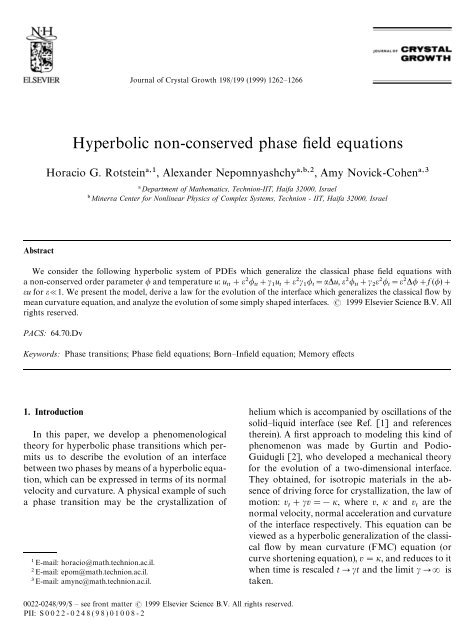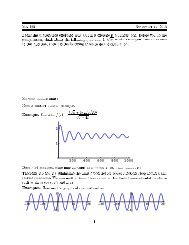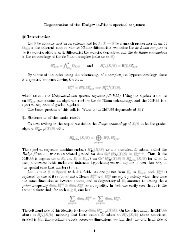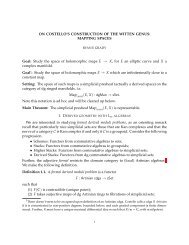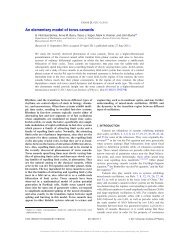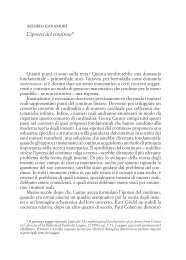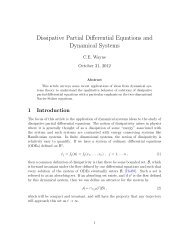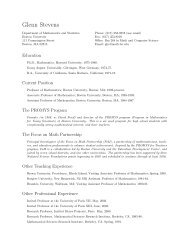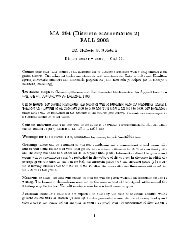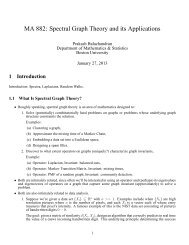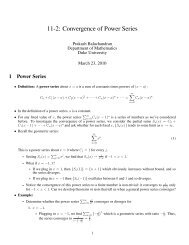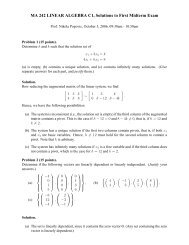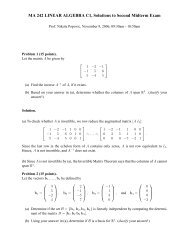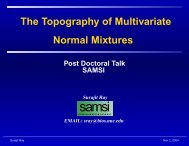Hyperbolic non-conserved phase field equations
Hyperbolic non-conserved phase field equations
Hyperbolic non-conserved phase field equations
You also want an ePaper? Increase the reach of your titles
YUMPU automatically turns print PDFs into web optimized ePapers that Google loves.
Abstract<br />
Journal of Crystal Growth 198/199 (1999) 1262—1266<br />
<strong>Hyperbolic</strong> <strong>non</strong>-<strong>conserved</strong> <strong>phase</strong> <strong>field</strong> <strong>equations</strong><br />
Horacio G. Rotstein, Alexander Nepomnyashchy, Amy Novick-Cohen<br />
Department of Mathematics, Technion-IIT, Haifa 32000, Israel<br />
Minerva Center for Nonlinear Physics of Complex Systems, Technion - IIT, Haifa 32000, Israel<br />
We consider the following hyperbolic system of PDEs which generalize the classical <strong>phase</strong> <strong>field</strong> <strong>equations</strong> with<br />
a <strong>non</strong>-<strong>conserved</strong> order parameter and temperature u: u # # u # "u, # "#f ()#<br />
u for 1. We present the model, derive a law for the evolution of the interface which generalizes the classical flow by<br />
mean curvature equation, and analyze the evolution of some simply shaped interfaces. 1999 Elsevier Science B.V. All<br />
rights reserved.<br />
PACS: 64.70.Dv<br />
Keywords: Phase transitions; Phase <strong>field</strong> <strong>equations</strong>; Born—In<strong>field</strong> equation; Memory effects<br />
1. Introduction<br />
In this paper, we develop a phenomenological<br />
theory for hyperbolic <strong>phase</strong> transitions which permits<br />
us to describe the evolution of an interface<br />
between two <strong>phase</strong>s by means of a hyperbolic equation,<br />
which can be expressed in terms of its normal<br />
velocity and curvature. A physical example of such<br />
a <strong>phase</strong> transition may be the crystallization of<br />
E-mail: horacio@math.technion.ac.il.<br />
E-mail: epom@math.technion.ac.il.<br />
E-mail: amync@math.technion.ac.il.<br />
0022-0248/99/$ — see front matter 1999 Elsevier Science B.V. All rights reserved.<br />
PII: S 0 0 2 2 - 0 2 4 8 ( 9 8 ) 0 1 0 0 8 - 2<br />
helium which is accompanied by oscillations of the<br />
solid—liquid interface (see Ref. [1] and references<br />
therein). A first approach to modeling this kind of<br />
phenome<strong>non</strong> was made by Gurtin and Podio-<br />
Guidugli [2], who developed a mechanical theory<br />
for the evolution of a two-dimensional interface.<br />
They obtained, for isotropic materials in the absence<br />
of driving force for crystallization, the law of<br />
motion: v #v"!, where v, and v are the<br />
normal velocity, normal acceleration and curvature<br />
of the interface respectively. This equation can be<br />
viewed as a hyperbolic generalization of the classical<br />
flow by mean curvature (FMC) equation (or<br />
curve shortening equation), v", and reduces to it<br />
when time is rescaled tPt and the limit PR is<br />
taken.
Our approach consists in considering the hyperbolic<br />
<strong>phase</strong> <strong>field</strong> model<br />
u ## # u # "u,<br />
# "#f ()#u, (1)<br />
in a bounded region LR with Dirichlet and<br />
Neumann boundary conditions for the temperature<br />
<strong>field</strong> and the order parameter respectively. Here<br />
u represents a temperature <strong>field</strong>, is an order<br />
parameter, , and are <strong>non</strong>-negative constants,<br />
and f () is a real odd function with a positive<br />
maximum equal to *, a negative minimum equal<br />
to !* and precisely three zeros in the closed<br />
interval [!a, a] located at 0 and $a, where a is<br />
a positive constant. System (1) is a hyperbolic version<br />
of the classical <strong>phase</strong> <strong>field</strong> model<br />
u # "u, "#f ()#u. (2)<br />
For Eq. (2), it has been shown that if the temperature<br />
<strong>field</strong> is initially equal to the melting temperature<br />
and Dirichlet boundary conditions are<br />
imposed on the temperature <strong>field</strong>, a plane interface<br />
moves according to the FMC equation (see Ref. [3]<br />
and references therein). Planar convex curves which<br />
move according to this law remain convex and<br />
become asymptotically circular as they shrink.<br />
Moreover planar embedded curves become convex<br />
without developing singularities (see Ref. [4] and<br />
references therein).<br />
A derivation of the hyperbolic <strong>phase</strong> <strong>field</strong> model<br />
is sketched in Section 2. In Section 3 we study the<br />
interface motion for Eq. (1). We present a geometric<br />
equation of motion which may be obtained in<br />
a particular asymptotic limit from Eq. (1) which<br />
extends the classical FMC equation and we study<br />
the evolution of some simply shaped interfaces<br />
which move according to this law of motion.<br />
A more detailed derivation of the model and of the<br />
equation for interfacial motion, as well as a description<br />
of the algorithm of its solution, will be presented<br />
elsewhere [5].<br />
2. The <strong>equations</strong><br />
H.G. Rotstein et al. / Journal of Crystal Growth 198/199 (1999) 1262–1266 1263<br />
We consider a material which can be in either of<br />
the two <strong>phase</strong>s: solid or liquid and which occupies<br />
a fixed region in space, LR, N"1, 2, 3 possessing<br />
a smooth boundary. These two <strong>phase</strong>s are assumed<br />
to be separated by a transition zone of finite<br />
thickness which we approximate by a sharp interface<br />
to be defined more precisely later. If the interface<br />
is planar, then at the interface the solid and<br />
liquid may coexist in equilibrium at a constant<br />
temperature ¹ , called the planar melting temperature.<br />
We define the reduced temperature<br />
¹"¹(x, t) to be the difference between the actual<br />
and the planar melting temperature; i.e.,<br />
¹(x, t):"(x, t)!¹ . For planar interfaces, positive<br />
reduced temperatures correspond to the liquid<br />
<strong>phase</strong>, while negative reduced temperatures correspond<br />
to the solid <strong>phase</strong>. In the classical <strong>phase</strong>-<strong>field</strong><br />
model, the two <strong>phase</strong>s may be characterized by<br />
different values of an order parameter, , which is<br />
assumed to vary continuously though the interface,<br />
assuming the value !1 in the solid (¹(0), #1in<br />
the liquid (¹'0), and having rapid spatial variation<br />
normal to the interface (see Ref. [6] and<br />
references therein). The internal energy of the system,<br />
e(x, t), is taken to be<br />
e(x, t):"¹(x, t)# (x, t), (3)<br />
where l is the latent heat of melting or solidification.<br />
The classical theory of heat conduction based on<br />
Fourier’s law does not take into account memory<br />
effects present in some materials and predicts that<br />
all thermal disturbances at a given point in the<br />
body are felt immediately throughout the whole<br />
body. A theory of heat conduction with finite wave<br />
speeds for isotropic materials, has been developed,<br />
which when linearized, yields the following expression<br />
for the heat flux [7]<br />
<br />
q"! A (s)e¹(t!s)ds, (4)<br />
<br />
<br />
where the kernel or “heat relaxation function” A (s)<br />
has been assumed to be a differentiable scalarvalued<br />
function on (0,R) such that A (R)"0. We<br />
shall limit our considerations here to exponentially<br />
decreasing kernels A (t)"e where and are<br />
<strong>non</strong>-negative constants. A review of finite and infinite<br />
wave propagation is given in Ref. [8]. When no<br />
heat is supplied to the body by external sources,
1264 H.G. Rotstein et al. / Journal of Crystal Growth 198/199 (1999) 1262–1266<br />
the internal energy e"e(x, t) and the flux are related<br />
by<br />
eR "!div q. (5)<br />
Combining Eqs. (3), (5) and (4) yields [9,10]<br />
<br />
¹ # "K A (t!t)¹(t)dt. (6)<br />
<br />
<br />
The free energy, F , of the system is assumed to<br />
be of the form<br />
F ()"<br />
<br />
2 ()#F()<br />
!S ¹ dx, (7) <br />
where is a correlation length [6]. The term involving<br />
the gradient is assumed to arise as a consequence<br />
of long range interactions, the function F()<br />
is a double-well potential (the free energy density at<br />
zero temperature of spatially homogeneous systems),<br />
is a positive constant, S is an entropy<br />
coefficient [11]. The term S ¹ represents temperature<br />
times relative entropy. The functional<br />
derivative of Eq. (7); i.e., F /(x)"!#<br />
F()/!S ¹, may be considered as a generalized<br />
force indicative of the tendency of the free energy to<br />
decay towards a minimum. We assume here that<br />
(x) decreases with a time averaged (rather than<br />
immediate) response to this generalized force:<br />
<br />
" A (t!t) #<br />
<br />
F()<br />
#S ¹ (t)dt. (8) <br />
Here A may be considered as a generalized force<br />
relaxation function with characteristics similar to<br />
A . Eqs. (6) and (8) will be henceforth called the<br />
<strong>phase</strong>-<strong>field</strong> <strong>equations</strong> with memory. Note that<br />
when A (t)"A (t)"(t), they reduce to the classical<br />
<strong>phase</strong> <strong>field</strong> <strong>equations</strong> [6]. By putting Eqs. (6)<br />
and (8) in dimensionless form, taking exponentially<br />
decreasing kernels, differentiating with respect to t,<br />
and rearranging terms we obtain Eq. (1), where<br />
f () states for the dimensionless form of F()<br />
(see Ref. [5] for details), under the scaling assumptions:<br />
"O(), "O(), "O() and "O().<br />
Let us note that another scaling "O(),<br />
"O(), "O() and "O() has also been<br />
considered [12]. Under appropriate assumptions<br />
on the kernel, this latter scaling provides a<br />
more general law for <strong>phase</strong> boundary motion,<br />
v" a(t!)()d. There the kernels were assumed<br />
to have an effective time scale for memory<br />
of O() which also corresponds to the assumed<br />
effective (dimensionless) thickness of the interface.<br />
3. Interface motion<br />
By formal asymptotic analysis of Eq. (1) taking<br />
1, we obtained that the interface, defined as<br />
(t; ):"x3 : (x, t; )"0 and treated as<br />
a moving internal layer of width O(), evolves according<br />
to the geometric law<br />
v #v(1!v)!(1!v)"0, (9)<br />
where denotes . Here v is the velocity in the<br />
normal direction to the interface, and is its curvature.<br />
We focused on the dynamics of a fully developed<br />
layer and not on the process by which it<br />
was generated. A general investigation of the interface<br />
motion governed by Eq. (9) is beyond the<br />
scope of the present paper. Here we will consider<br />
some simple particular cases.<br />
For a circular interface with radius R (t), Eq. (9)<br />
may be written as [13]<br />
1<br />
R "! #R<br />
R <br />
<br />
(1!R ). (10)<br />
<br />
For "0, if R (0)"f '0 and R (0)"0, then<br />
<br />
R (t)"f cos(t/f ). Thus circles shrink to points at<br />
<br />
time t where t "f /2, and R (1 for<br />
<br />
0(t(t . For '0, if R remains in the interval<br />
<br />
[!1, 0], then R (t)(0 for t3(0, t ), where t is the<br />
<br />
extinction time which we define to be such that<br />
R (t )"0 and R (t)'0 for all t(t . A <strong>phase</strong> plane<br />
<br />
analysis shows that for *0 circles shrink to<br />
points for all initial conditions such that<br />
!1(R (1 and curves starting in this region<br />
<br />
remain within it up to extinction time. The effect of<br />
positive is to delay the extinction time [13].<br />
The evolution of a perturbed circle has been<br />
studied numerically. As an illustration, the result of<br />
numerical calculations for a perturbed circle with
H.G. Rotstein et al. / Journal of Crystal Growth 198/199 (1999) 1262–1266 1265<br />
Fig. 1. Shrinkage of a perturbed circle for R(0)"1#0.1 sin(2), R (0)"!0.1. (a) "0 and t"0, 0.7, 1.2, 1.4. (b) "5 and t"0, 1.55,<br />
2.52, 2.95.<br />
initial shape and velocity given by R(0)"<br />
1#0.1 cos(2) and R (0)"!0.1 respectively and<br />
<br />
where equals 0 or 5 are shown in Fig. 1. For "0<br />
we see that the interface rotates as it shrinks. This<br />
phenome<strong>non</strong> is almost not observable for "5.<br />
The evolution of planar interfaces is described by<br />
the equation<br />
S #S (1!S )"0, (11)<br />
<br />
where y"S (t) represents the distance between the<br />
<br />
interface and the x-axis. Taking S (0)"f and<br />
<br />
S (0)"g , the solution of Eq. (11) for '0 is<br />
<br />
given by<br />
S (t)"f $ ln(g #)$tG ln(g <br />
#g#(1!g)e), (12)<br />
<br />
where the upper choice of signs correspond to<br />
g '0 and the lower choice of signs correspond to<br />
<br />
g (0. Note that the direction of propagation de-<br />
<br />
pends on the sign of g and as tPR the interface<br />
<br />
will cease to move and asymptotically approach the<br />
value f $(1/) ln(g#). When there is no<br />
<br />
damping ("0), the solution of Eq. (11) is given by<br />
S (t)"f #g t. A perturbation analysis of planar<br />
<br />
interfaces on finite intervals with Neumann boundary<br />
conditions indicates that if "0, then <strong>non</strong>constant<br />
perturbations oscillate indefinitely, whereas<br />
if '0 initial perturbations are damped though<br />
oscillations may or may not occur depending on<br />
the initial perturbation and the value of .<br />
There also exist <strong>non</strong>-planar front solutions to<br />
Eq. (9) which propagate with constant velocity v;<br />
i.e., S(x, t)"SM (x)#vt, where SM (x) can be shown to<br />
satisfy<br />
(1!v)SM !v(1#SM !v)"0. (13)<br />
The solution of Eq. (13) is given by<br />
SM (x)" 1<br />
2a ln[1#tan(abx#c )]#c , (14)<br />
<br />
where a"v/(1!v), b"(1!v) and c and<br />
c are integration constants which depend on the<br />
initial conditions. This solution corresponds to<br />
a “finger” of width /ab whose orientation depends<br />
on the sign of v.<br />
4. Conclusions and discussion<br />
We have presented a hyperbolic extension of the<br />
classical <strong>phase</strong>-<strong>field</strong> <strong>equations</strong> and analyzed the<br />
special case given in Eq. (1). In this particular scaling<br />
we have demonstrated that the evolution of<br />
interfaces is governed by Eq. (9), a hyperbolic extension<br />
of the classical FMC equation.<br />
Let us note that Eq. (1) is also relevant for other<br />
physical processes like propagation of kinks in<br />
Josephson junctions, magnetics, etc. [13]. In particular,<br />
for "0, the Cartesian version of Eq. (9) is<br />
known as the Born—Infeld equation. The geometric<br />
description of the evolution of interfaces has the
1266 H.G. Rotstein et al. / Journal of Crystal Growth 198/199 (1999) 1262–1266<br />
advantage that it permitted us to develop and use<br />
a crystalline algorithm to study the motion of<br />
curves by constructing facetted approximations to<br />
them. This algorithm which requires less calculations<br />
than classical methods of solving PDEs is<br />
described elsewhere [14].<br />
References<br />
[1] A.Y. Keshishev, A.Y. Parshin, A.V. Babkin, Sov. Phys.<br />
JETP 30 (1990) 56.<br />
[2] M.E. Gurtin, P. Podio-Guidugli, SIAM J. Math. Anal. 22<br />
(1991) 575.<br />
[3] G. Caginalp, Rocky Mountain J. Math. 21 (1991) 603.<br />
[4] M.A. Grayson, J. Differential Geom. 26 (1987) 285.<br />
[5] H.G. Rotstein, A.A. Nepomnyashchy, A. Novick-Cohen,<br />
1998, preprint.<br />
[6] G. Caginalp, Arch. Rat. Mech. Anal. 92 (1986) 205.<br />
[7] M.E. Gurtin, A.C. Pipkin, Arch. Rat. Mech. Anal. 31 (1968)<br />
113.<br />
[8] D.D. Joseph, L. Preziosi, Rev. Mod. Phys. 61 (1989) 41.<br />
[9] A. Novick-Cohen, in: Curvature Flows and Related<br />
Topics, GAKUTO Math. Sci. Appl., vol. 5, 1995, pp.<br />
179—198.<br />
[10] S. Aizicovici, V. Barbu, NoDea 3 (1996) 1.<br />
[11] G. Caginalp, P.C. Fife, SIAM J. Appl. Math. 48 (1998) 506.<br />
[12] A. Novick-Cohen, in preparation.<br />
[13] H.G. Rotstein, A.A. Nepomnyashchy, 1998, preprint.<br />
[14] H.G. Rotstein, S. Brandon, A. Novick-Cohen, J. Crystal<br />
Growth 198/199 (1999) 1256.


